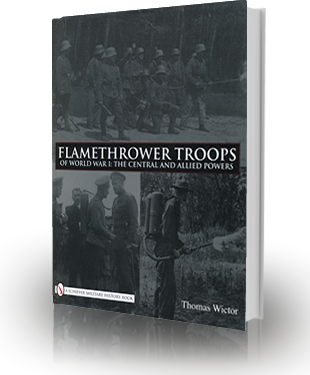Chapter Six: Italy
1915
June 23-July 7 - The Austrians first used flamethrowers against the Italians on the Carso, during the First Battle of the Isonzo.
Autumn - The Italians acquired 24 Schilt No. 1 and No. 2 flamethrowers from the French.
October 16 - The Italian Supreme Army Command (Comando Supremo) ordered engineers with previous experience as firemen to Udine to experiment with flamethrowers under the command of engineer Captain Tassinari, fire chief of Turin. Captain Schilt of the Paris Firefighting Sapper Regiment trained these first flamethrower operators.
October 31 - The Independent Flamethrower Unit (reparto lanciafiamme autonomo) was organized at Cervignano, under the command of the engineers of the Third Army. It was made up of firefighters and sappers (zappatori) of the 1st Engineer Regiment (1º Reggimento Genio), a total of one officer and 40 men dubbed flammieri.
1916
April 20 - The Independent Flamethrower Unit first saw action at Selz.
May 15 - By order of the 14th Division nine soldiers from the 14th Infantry Regiment and six from the 13th were sent to Ronchi to serve with the Independent Flamethrower Unit. At midnight the Austrians attacked with flamethrowers, setting fire to the trench without causing any casualties to the Italians. An hour later they attacked again, but this time Squad Bosani of the flamethrower unit responded with its own device, forcing the Austrians to retreat. The Italian flamethrower was damaged in the fighting and taken out of action.
June - The Independent Flamethrower Unit had amassed an arsenal of 22 large and medium Schilt apparatuses, two Hersent-Thirion, and three captured Austrian flamethrowers.
July - The 2nd Engineer Regiment (2º Reggimento Genio) of the First Army formed the Independent Flamethrower Platoon (plotone lanciafiamme autonomo) of 70 men, ten of whom were transferred in from the Independent Flamethrower Unit.
August 10 - The Supreme Command ordered the Third Army to establish two flamethrower companies (compagnie lanciafiamme), the first built around the Independent Flamethrower Unit and the second created from scratch. This order also authorized the First Army to retain the Independent Flamethrower Platoon.
September - The Third Army organized two flamethrower companies in the 1st Engineer Regiment, based on the French model. Each company was composed of four 53-man sections (sezioni lanciafiamme):
two medium Schilt No. 2 (initially called “portable”) sections,
one static Schilt No. 1 section,
one mixed static Schilt and Hersent-Thirion section.
Each section, armed with 12 flamethrowers, was divided into three squads that were each commanded by a sergeant and equipped with four devices. These three squads each established two combat posts; a combat post was armed with two flamethrowers and commanded by an NCO or corporal.
October - The Third Army increased its medium-flamethrower sections to eight and added one flamethrower command; the First Army expanded the Independent Flamethrower Platoon into four flamethrower sections and one flamethrower command.
During this month the Schilt No. 2 medium flamethrower was reclassified as a static weapon, since it was too heavy to be carried into action behind assault troops. As a result, the 1st Engineer Regiment began investigating small portable flamethrowers.
At around this time a general flamethrower depot was established at Porpetto, consisting of a group command and four flamethrower sections for the training of personnel. Each of the eight medium-flamethrower sections of the Third Army was assigned to a different infantry division, their administration and discipline the responsibility of the commander of the divisional engineer battalions.
November 20 - The Supreme Command established the Flamethrower Direction (Direzione dei Lanciafiamme) at Porpetto to more efficiently administrate the two flamethrower companies and the flamethrower depot. The Flamethrower Direction consisted of a captain, a lieutenant, one corporal, and four enlisted men.
A third flamethrower company was also established with this order, along with a flamethrower-personnel depot and a depot for flamethrower material, all located at Porpetto.
The 1st Flamethrower Company was comprised of four sections (31st - 34th) based in Verona and assigned to the First Army.
The 2nd Flamethrower Company contained eight sections (1st - 8th) based in Turriaco.
The 3rd Flamethrower Company was composed of four sections (9th, 10th, 35th, 36th) based at the depot at Porpetto.
At around this time the Schilt No. 3 portable flamethrower arrived in Italy. Its many shortcomings were immediately recognized. Although it was issued to the flamethrower companies, the Flamethrower Direction planned to replace it as soon as possible.
With the adoption of the Schilt No. 3, four types of sections were organized in the flamethrower companies:
Type A - armed with 12 Schilt No. 1 heavy static apparatuses;
Type B - armed with 12 Schilt No. 2 medium semi-portable apparatuses;
Type C - armed with 12 Schilt No. 3 small portable devices;
Mixed Type - armed with 12 Schilt No. 1 static and two Hersent-Thirion apparatuses.
Types A, B, and C were composed of one subaltern, one sergeant, three corporals, and 48 men. The Mixed Type had four extra flamethrower carriers, for a total of 57 personnel.
The center of mobilization for all flamethrower personnel was the depot of the 1st Engineer Regiment at Pavia.

